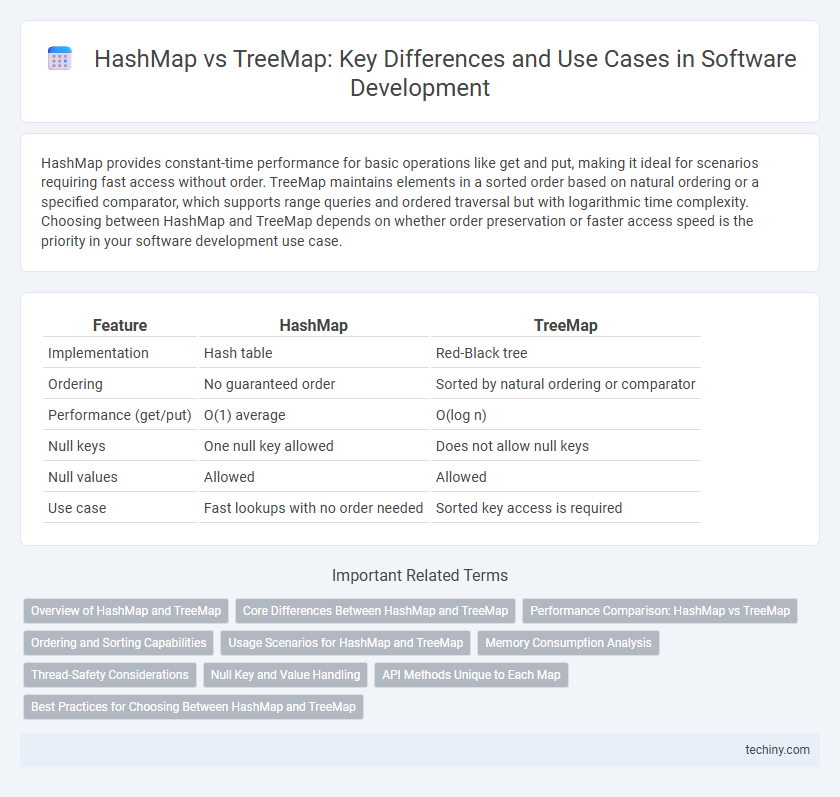HashMap provides constant-time performance for basic operations like get and put, making it ideal for scenarios requiring fast access without order. TreeMap maintains elements in a sorted order based on natural ordering or a specified comparator, which supports range queries and ordered traversal but with logarithmic time complexity. Choosing between HashMap and TreeMap depends on whether order preservation or faster access speed is the priority in your software development use case.
Table of Comparison
| Feature | HashMap | TreeMap |
|---|---|---|
| Implementation | Hash table | Red-Black tree |
| Ordering | No guaranteed order | Sorted by natural ordering or comparator |
| Performance (get/put) | O(1) average | O(log n) |
| Null keys | One null key allowed | Does not allow null keys |
| Null values | Allowed | Allowed |
| Use case | Fast lookups with no order needed | Sorted key access is required |
Overview of HashMap and TreeMap
HashMap stores key-value pairs based on hash codes, providing average O(1) time complexity for insertions and lookups, making it highly efficient for unordered data retrieval. TreeMap stores key-value pairs in a Red-Black tree structure, ensuring sorted order of keys and offering O(log n) time complexity for basic operations. HashMap allows null keys and values, whereas TreeMap does not permit null keys, emphasizing their different use cases in software development.
Core Differences Between HashMap and TreeMap
HashMap stores key-value pairs using a hash table, providing constant-time O(1) complexity for basic operations like get and put, while TreeMap uses a Red-Black tree structure to maintain sorted order with O(log n) time complexity. HashMap allows one null key and multiple null values, whereas TreeMap does not permit null keys but allows null values. TreeMap guarantees natural ordering or a custom comparator order, whereas HashMap offers no ordering guarantees.
Performance Comparison: HashMap vs TreeMap
HashMap offers constant-time O(1) average performance for insertions, deletions, and lookups due to its underlying hash table structure, making it highly efficient for most use cases. TreeMap, implemented as a Red-Black tree, provides logarithmic O(log n) time complexity for these operations, which is slower compared to HashMap but guarantees sorted key order. When performance is critical and sorting is unnecessary, HashMap is preferred; however, TreeMap is optimal for scenarios requiring natural ordering or range queries.
Ordering and Sorting Capabilities
HashMap provides constant-time performance for basic operations like get and put but does not guarantee any ordering of its entries. TreeMap maintains a sorted order of keys based on their natural ordering or a specified Comparator, enabling efficient range queries and ordered traversal. When predictable iteration order or sorted data is required, TreeMap is preferred despite its slightly higher logarithmic time complexity compared to HashMap's average constant time.
Usage Scenarios for HashMap and TreeMap
HashMap is ideal for scenarios requiring fast, constant-time performance for basic operations such as insertions and lookups, making it suitable for caching, indexing, and hash-based collections where order does not matter. TreeMap is preferred when sorted order is needed, supporting operations like range queries and ordered traversal in applications requiring natural key ordering or a custom comparator, such as implementing navigable maps and priority queues. Choosing between HashMap and TreeMap depends on whether performance or order guarantees are more critical for the specific software development task.
Memory Consumption Analysis
HashMap typically consumes less memory than TreeMap due to its underlying hash table structure, which stores only key-value pairs without maintaining order. TreeMap requires additional memory for its Red-Black tree nodes, including parent and child pointers, to preserve sorted key order. This difference makes HashMap more memory-efficient when order is not a priority in software development.
Thread-Safety Considerations
HashMap is not thread-safe and can lead to data inconsistency when accessed concurrently without external synchronization, making it unsuitable for multi-threaded environments without proper locking mechanisms. TreeMap also lacks inherent thread safety, requiring synchronized wrappers like Collections.synchronizedSortedMap or explicit synchronization to avoid concurrent modification exceptions. For thread-safe alternatives, ConcurrentHashMap provides high concurrency without locking the entire map, while ConcurrentSkipListMap offers a thread-safe sorted map implementation similar to TreeMap.
Null Key and Value Handling
HashMap allows one null key and multiple null values, enabling flexible insertion of entries without key restrictions. TreeMap does not permit null keys as it relies on natural ordering or a Comparator, which cannot compare null, but it allows multiple null values. When choosing between the two for null handling, HashMap is preferable for scenarios requiring null keys, whereas TreeMap is suited for sorted key storage without null key support.
API Methods Unique to Each Map
HashMap offers unique methods such as putIfAbsent(K key, V value), which inserts a key-value pair only if the key is not already present, and computeIfAbsent(K key, Function mappingFunction), allowing dynamic value computation upon key absence. TreeMap provides exclusive API methods like firstKey() and lastKey() to retrieve the lowest and highest keys respectively, and subMap(K fromKey, K toKey) for creating a view of a portion of the map based on key range. These methods illustrate HashMap's emphasis on fast, unordered retrieval and TreeMap's focus on sorted key operations.
Best Practices for Choosing Between HashMap and TreeMap
Selecting between HashMap and TreeMap hinges on specific use cases and performance needs; HashMap excels in constant-time complexity for insertions and lookups, ideal for unordered key-value storage. TreeMap guarantees sorted keys and supports navigable map operations with logarithmic time complexity, making it suitable when order matters or range queries are frequent. Developers should prioritize HashMap for high-performance, unsorted data retrieval and TreeMap when natural ordering and predictable iteration order are critical in software development.
HashMap vs TreeMap Infographic

 techiny.com
techiny.com